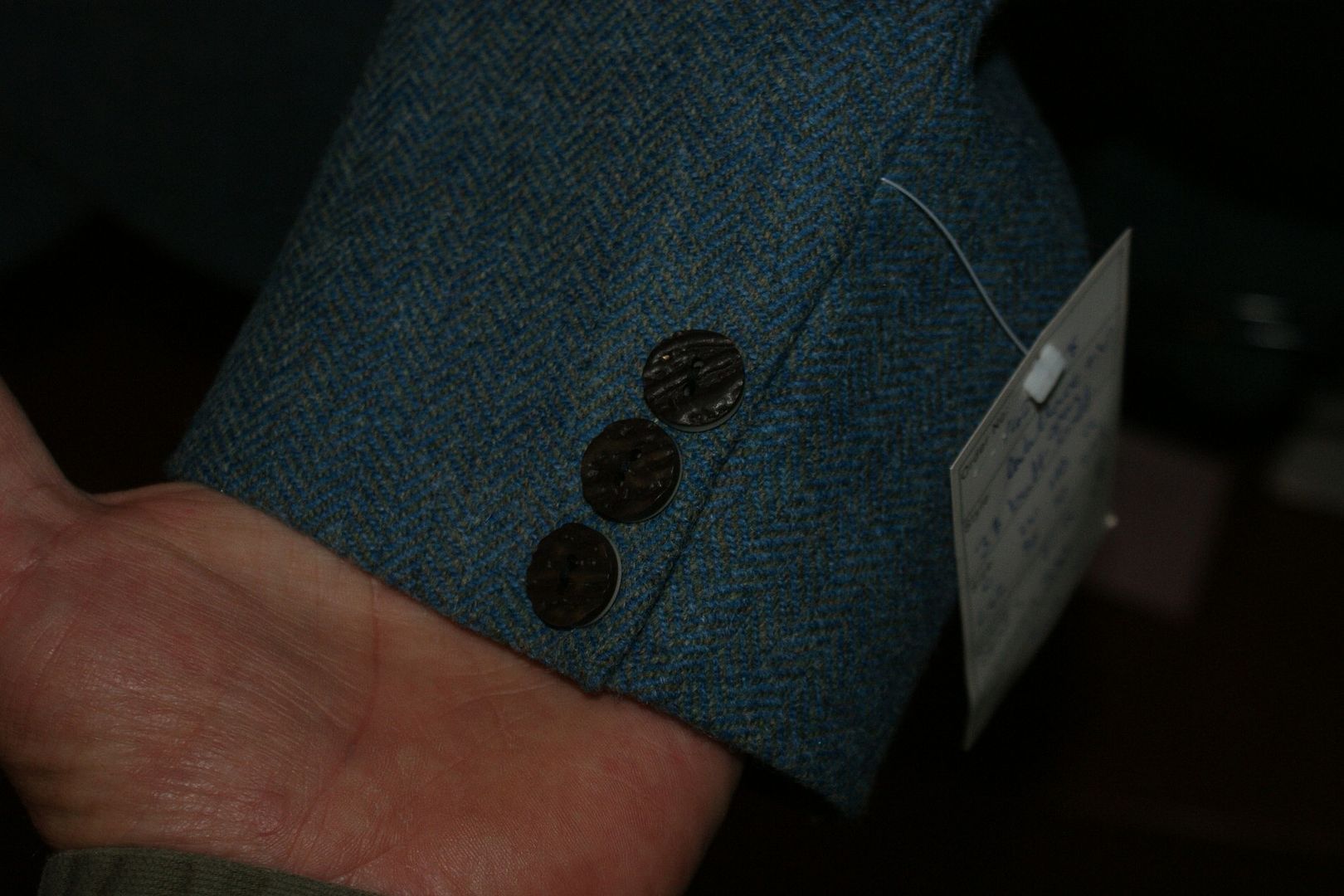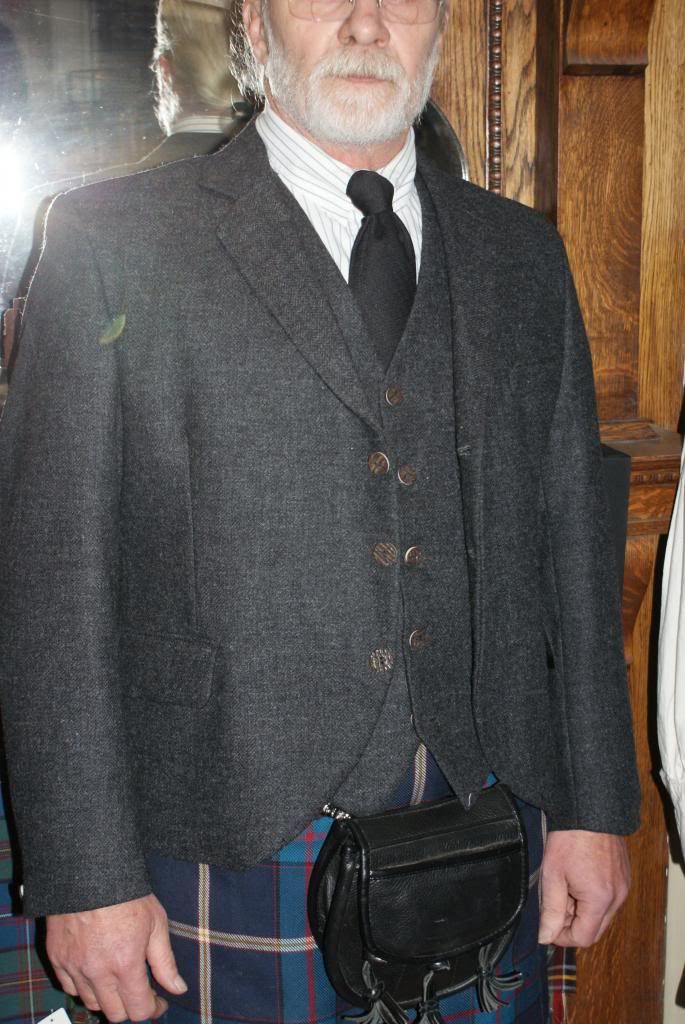|
-
8th October 16, 07:17 PM
#1
is there a difference between an argyle and a regular blazer?
-
-
9th October 16, 01:19 AM
#2
Aye, there are. Very distinct differences.
The length of a suit or sport coat is usually long, about the bottom of the buttocks. This is to hide the pucker caused by the legs of trousers.
A coat cut for a kilt is shorter. About the crest of the butt and hips. This length does not hide the pleats of the kilt.
A kilt cut coat will also be cut away in the front to make room for the sporran.
They will normally have two side vents in back to give a smooth rear across the pleats.
Other then these differences the names of the jackets come from the cuff treatment.
These names are not standard among makers but these are perhaps the most common.
Left to right
A single button on a closed cuff is called a Crail.
The gauntlet cuff is called an Argyle.
The placket style is called a Braemer.

What we have come to think of as an Argyle is usually has a single button front closure. Before the current standardization you could find two and sometimes even three button fronts. The sporran cut-away causes no end of problems when you try to convert a regular, long sport or suit coat to a kilt jacket due to the lower buttonhole location.
Another problem is the pocket placement. A suit or sport coats pockets are lower. When you cut off the bottom to convert a sport coat to kilt length the pockets usually appear too low or too near the bottom.
There are two newer kilt jackets which are becoming popular. They are the Wallace cut and the Kilt Kut suit coat.
Both have straighter, three button fronts, no epaulettes and no scalloping or buttoning of the pocket flaps.
The Kilt Kut Suit Coat has a true, three button open cuff, and is cut a bit fuller for N. American tastes.


Last edited by Steve Ashton; 9th October 16 at 01:37 AM.
-
-
9th October 16, 05:40 AM
#3
Here's a classic Argyll jacket

Note the high buttoning-point, more or less in line with the elbows. It's designed to work with traditional kilts which come up that high.
Here's what it looks like when you wear a jacket with the kilt that's not cut-away like kilt jackets are

Last edited by OC Richard; 9th October 16 at 05:47 AM.
Proud Mountaineer from the Highlands of West Virginia; son of the Revolution and Civil War; first Europeans on the Guyandotte
-
-
9th October 16, 05:45 AM
#4
Well... both types DO have sleeves. Other than that . . . .
Rev'd Father Bill White: Mostly retired Parish Priest & former Elementary Headmaster. Lover of God, dogs, most people, joy, tradition, humour & clarity. Legion Padre, theologian, teacher, philosopher, linguist, encourager of hearts & souls & a firm believer in dignity, decency, & duty. A proud Canadian Sinclair with solid Welsh and other heritage.
-
-
9th October 16, 10:18 AM
#5
What level of formality are the Wallace cut and the kilt kut?
-
-
9th October 16, 11:21 AM
#6
In general -
The Prince Charlie Coatee and waistcoat are the most formal. The kilt equivalent of the Tuxedo. Worn whenever tuxedo/black tie is required.
The Argyle is actually more versatile than the Prince Charlie. Worn with Tux shirt (studs and cufflinks) and black bow tie it can go up to tuxedo equivalent. When worn with a dress shirt and long tie it can be suitable for anything else. It can be worn with or without the vest. I have seen it worn as day wear.
The Tweed Argyle is day wear. Or anywhere you would wear a jacket and tie. But not usually evenings.
The Wallace is almost always made from black barathea cloth. With its slim, European cut it is very much at home for evening events. With dress shirt, tie and vest it can go to the office. And can easily be worn during the day.
The Kilt Kut is a de-militarized version of the Argyle with the jacket cut in the N. American fuller style. Depending on the fabric it is made from it easily goes from day wear to office to evening. Basically anywhere you would wear a jacket and tie or a suit.
-
-
9th October 16, 11:47 AM
#7
If I may split a hair Steve? The tweed argyll and appropriate kilt accoutrements is the kilt version and the equivalent of, the lounge/business suit and as such is perfectly at home and "correct" for any smart-----but not formal---- evening do. To limit the tweed argyll to mostly daywear is unhelpfully inaccurate.
Just saying.
Last edited by Jock Scot; 9th October 16 at 11:49 AM.
" Rules are for the guidance of wise men and the adherence of idle minds and minor tyrants". Field Marshal Lord Slim.
-
The Following 3 Users say 'Aye' to Jock Scot For This Useful Post:
-
9th October 16, 01:04 PM
#8
I will stand corrected Jock. Perhaps it would be more correct to say that, I personally, would not wear Tweed for evening events.
As I do not live in the UK I do not use UK terms such as 'lounge". Here in N. America business attire is not the same as evening attire. I could, but would not, wear the same suit to the office that I would wear to the theatre or other event that falls between business and formal. But then again, N. America no longer has an equivalent to the (almost uniform) of a British Banker.
-
-
9th October 16, 01:23 PM
#9
Nations divided by a common language, amonst other things I suspect Steve.
However, we are discussing this subject in the "Traditional Kilt section" which implies to me at least that a British viewpoint is entirely valid. Had this subject been discussed in the "Contemporary Section" then I can quite see a wider viewpoint is another matter altogether.
Nevertheless the point has been made that the tweed argyll is perfectly acceptable to be worn for non formal evening events, particularly when viewed from the traditional angle.
Last edited by Jock Scot; 9th October 16 at 01:32 PM.
" Rules are for the guidance of wise men and the adherence of idle minds and minor tyrants". Field Marshal Lord Slim.
-
-
9th October 16, 01:42 PM
#10
And Jock, that is why I used the traditional concept that Tweeds were "country" wear.
-
 Posting Permissions
Posting Permissions
- You may not post new threads
- You may not post replies
- You may not post attachments
- You may not edit your posts
-
Forum Rules
|
|
Bookmarks